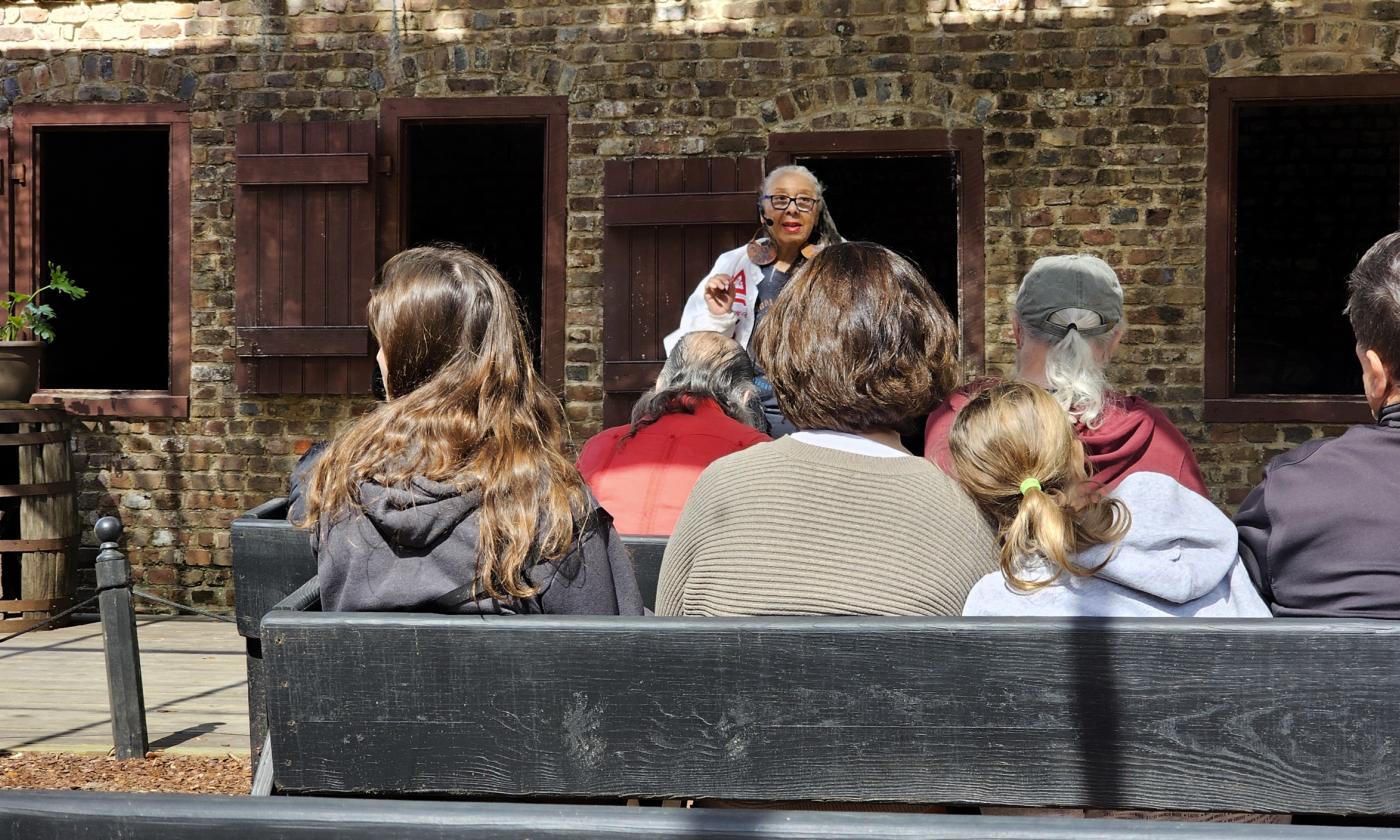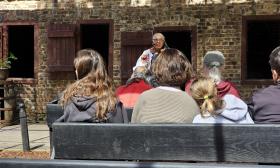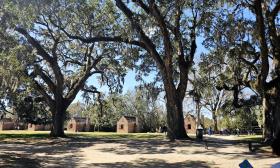
Oral Historian Discusses The Gullah Geechee Language
Charleston historian shares stories in a dialect unique to the southeastern United States.
Oral Historian Discusses The Gullah Geechee Language
A Recognized National Historic Area
On October 12, 2006, Congress passed the S.203 National Heritage Areas Act of 2006, formally acknowledging the historical and cultural importance of the Gullah Geechee nation. The Gullah Geechee Heritage Corridor encompasses 12,000 square miles.
Managed by the U.S. National Park Service, the Gullah Geechee Cultural Heritage Corridor's purpose is to:
Preserve, share and interpret the history, traditional cultural practices, heritage sites, and natural resources associated with Gullah Geechee people [...]
With a coastal territory spanning from Jacksonville North Carolina to Jacksonville Florida, the Corridor is the homeland of a unique creole culture whose earliest generations were enslaved in British Carolina.
St. Augustine, Florida is currently considered the southernmost region of the Heritage Corridor. (Though, some are rallying for its borders to be extended all the way to Key West.)
The Fatal Middle Passage
"The cow tail switch is a symbol of authority and it's usually carried by the king or the chief, whoever's in charge, "King said. "But the one other person who gets to carry the cow tail switch is the official storyteller, "The Griot. "(pronounced gree-oh)
King notes that 40 to 80 percent of the Africans who were captured were immediately transported to Charleston.
Charleston, SC: America's Slavery capital
In the 1700s and 1800s, Sullivan's Island (which lies across the harbor from the Charleston peninsula) was used as an early holding ground for captured Africans who would be enslaved in the Carolinas and beyond.
There, enslaved people were confined within cramped houses, subjected to examinations for diseases, and threatened to deter any escape attempts. After being processed on Sullivan's Island, some were often auctioned off in downtown Charleston, while others were taken farther away.
"Most of the families were broken up before they got on the slave ships, "King said. "Father might be sold to a plantation in Virginia, perhaps mother to a plantation in Georgia, and the children remained in South Carolina."
In most cases, these families were never reunited and were subjected to grueling labor on plantations. King admits life for the Gullah Geechee people was unpleasant.
"The Gullah people say that they worked from Kintsee to Kintsee, "King said. "From Kintsee to Kintsee — can't see 'till can't see, meaning all day long. "
King explains that the term "Gullah'' originates from the country of Angola in West Africa, where many of its inhabitants were captured. On the other hand, "Geechee '' is thought to derive from the Ogeechee River near Savannah. Both cultural identities are known as the Gullah Geechee, and suggest both African and Indigenous influences.
The Gullah Geechee Language
The unique language shared among the Gullah Geechee people is a unifying factor for this unique American ethnic group.
"Years ago, I had the opportunity to go to Senegal in West Africa, and I was surprised to find out there were six distinct languages, "King said."So when the people were put on the ships, they had no way of communicating with each other. They brought their tribal languages, and mixed with English, Dutch, Portuguese, Spanish, and French… the languages of people conquering them."
Its Own Complex System
Despite often being labeled as uneducated and unsophisticated due to public misconceptions about their culture, King emphasizes that the Gullah Geechee language is not a form of poor English.
"In the 1930s, Dr. Lorenzo Dow Turner was teaching at South Carolina State College at Orangeburg and had these students who came from the Lowcountry, and he noticed this distinctive pattern of talking, "King said. "So, he made a trip over to Africa, and he went to the West Indies, and he came to the Lowcountry, and went to Georgia. He spent a lot of time on Edisto Island, one of the major Barrier Islands off the coast of South Carolina. And he listened to the people. He recorded them. "
Turner was the first person to identify Gullah as a bonafide language.
Examples of Gullah Geechee Language
When mentioning sample words in Gullah, King explains the use of some common words.
"There's no such thing as a 'th' sound, "King said. "Thank you becomes tanky. Number three becomes tree. The word for woman is oman. It's the woman without the 'w.' "
There is no distinction between the male and female pronouns in the language. Everything is ee and this includes animals. A great example of this is in the Gullah Geechee saying, "Ee crack ee teet, "which means that a person smiled or laughed.
Religious and Spiritual Beliefs of the Gullah Geechee People
Aside from having a distinguishable language, the Gullah Geechee religions and traditions are also unique from different cultures.
"Gullah people are usually superstitious, "King said."The color blue is considered very magical and they use it a lot in their home. They paint the door jamb blue or the window sills blue, around the chimney, or the porch ceiling. Sometimes the whole house is painted blue and it's done deliberately… to keep the evil spirits, including the hag away."
Like many other cultures, the Gullah Geechee people believe essentials are buried with loved ones. King explains items such as medicine bottles, teaspoons, clocks, and other objects used in life are required after death.
Gullah Geechee Cuisine
When King thinks about shrimp and grits, gumbo, okra, and other Southern recipes, she reminds us that they come from the Gullah Geechee culture.
"Okra soup is like our version of gumbo, "King said. "You may also see the dish called perlo, or purloo. It's spelled in different ways. This is simply a main dish that's made with rice. It could be shrimp or chicken perlo. You might want to try some. "
A Fable in the Gullah Geechee Language
To assess everyone's grasp of the Gullah language, King wraps up her lecture with the following tale:
Once, a long long time ago, Brer Rabbit, and Brer Fox, Brer Fox, lived together just like brudders, don't you know. Now, Fox somehow gone and eself a girlfriend, gone to wisit em every day. Then he come home and brag to Rabbit about how e got a girlfriend, but Rabbit ain't got none.
Well now, directly, Rabbit get tired of bragging, so he said, I gonna fix em tomorrow for trute. Next day, for day clean, fox get up and he gone fushin' at the rildoer. At a day clean, Brer rabbit gone to visit Fox girlfriend.
Knock on the door. When Fox's girlfriend come to the door, e says, Good morning. I come down here to tell oona something. I come down to tell oona, Fox ain't no fox, you know. Fox is my father's cart horse. Does ride him every day before he comes down here to visit me. Then he get up, gone on home.
Well, let me tell you, dat evening, when Fox gone to wisit e girlfriend, e notice e girlfriend ain't been too friendly to em, wouldn't say anything to em, wouldn't pay em no mind. Directly, Fox say, oman what's wrong with oona? How come oona ain't pay me no proper tention, yeah?
Ee say, I ain't paying oona no proper tention, cause Brer Rabbit come down yere and tell me oona is e father's cart horse so he could ride oona every day. "Well, that ain't no trute. Brer Fox, get up, you sloppy footsie. I'll go bring him down here to tell you the trute. Well, now Brer Fox went on home and when e got there, Brer Rabbit was laying in the bed under the covers.
I said, how come you tell my girlfriend I was your father's cart horse? No brother, I didn't do dat. I ain't seen your girlfriend. I ain't been out dis house all day. I been too sick. I been in bed all day. Well, e said, you say um, you say um.
Rabbit said, brudder, would like to help oona but I too sick. I can't move out dis bed. And den dey commenced to argument. Fox, e say, oona gone come down and help me clear me name. If I got to carry oona on me back. Now Brer Rabbit, kraken e teet under the civers.
Ee crack e teet? Just a crack e teet? E said, All right, brudder. Since oona put it that way, I'll go with oona. So Brer Rabbit climbed pon top of Fox back and dey commenced to go. Now dey ain't been gone but two step and Brer Rabbit start moanin and groanin, holding e back like so. Oh, Oh!
Brer Fox say, What's wrong with oona huh? Brer Rabbit say, I want to go with oona, but me back is hurting. My back is hurting because my legs are swinging like dis. I need something to put me legs in, my foot in. Well, what do you need, huh? I need some of them things, um, hmm, some stirrup. If I had some stirrup, I'd go with oona.
So Fox gone in the barn, get the stirrup, tie em on his eself, come back out. Rabbit climbs pon top of him. Now they commenced to go in some more. This time they ain't been gone, but tree step, tree step. And the rabbit just moaning and groaning, even more. Fox saying wa wrong now? Well brudder, my foot's doing fine in the stirrup, but my back does hurt.
I need something to sit on. What oona need to sit on, huh? I need one of dem tings, um, a saddle. If I had a saddle, I could go wit oona good. So, Fox gone back to the barn, get the saddle, tie um on self, and, do a rapid climb back on e back. Well, now dis time they've been gone but five steps, five steps.
And, oh, Rabbit just a moanin and groanin even mo so. Oh, Rabbit, boy, what wrong with oona now? Brudder my foot's doin fine and I sit and fine in the saddle. But I still feel like I go, off oona back. I need something to hold on to when I run. Well, what do oona need, huh?
I need some, um, some reins. If I had some reins, I could go good. Now, all Brer Fox can tink about is going to clear e name, so e go in the barn, get the reins, tie um on eself, and when he come back out there, Brer Rabbit's standing dere wit a whoop in e hand and some spurs e foot.
What dem tings for, huh? Brudder, how I gon get the fly off oona nose, huh? How I gon get the fly off your side? So, he climbed back on top of Brer Fox's back and he commenced to go in some more. Now directly, they gettin close to Brer Fox's girlfriend house, and Brer Fox says, Okay, oona gonna get off now because we gettin close to the house.
The rabbit said, Oh no, brudder, still too far, still too far, go a little furter. So they blend right in. Before you know it, they're right there, right there at Brer Fox Girlfriend house. And there's Brer Fox Girlfriend sitting on the porch lookin at um. And when Brer rabbits see dat, they take that whoop, and they whoop him on the nose, and they take those spurs, and they jug um in do side, and they stand up skrate in the saddle, and they say, See, ain't I done tell oona Brer Fox is my father's cart horse, I does ride um ewery day.
Brer Fox been too shame, too shame, all e could do is just walk up to the fence post. And when e did that, Brer Rabbit, e climbe from pon top of his back, and he tiec the reins to the fence post. Then he go on down and call eself courtin' Brer Fox girlfriend. But when Brer Fox see that, he get so mad!
He jug them reins off the fence post, and let me tell you something. He jug um so hard, the reins hit me right here on the side of my face, knocking me all the way up here to Boone Hall Plantation to tell y'all dis story.
This tale is merely a glimpse into narratives woven within the Gullah Geechee culture, eagerly awaiting a fresh cohort of storytellers, scholars, and enthusiasts to unearth.
For further insights into the projects and lectures of librarian, storyteller, and oral historian Minerva T. King, please email: [email protected]
The St. Augustine Black History App
Created in collaboration between Visit St. Augustine and Florida's Historic Coast, this resource brings history to the palm of your hand. Our mission is to connect the locals and visitors of today to significant stories of St. Augustine's African American History.
It is available for free on the Apple App Store and Google Play Store: St. Augustine Black History App Download Link.
Resources
Online Sources
Gullah Geechee Cultural Heritage Corridor
Official Website / Official Facebook
Gullah Talk: Dr. Lorenzo Dow Turner, YouTube video from Dr. Jessica Berry



